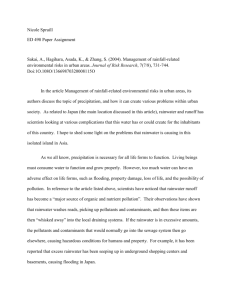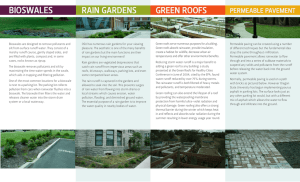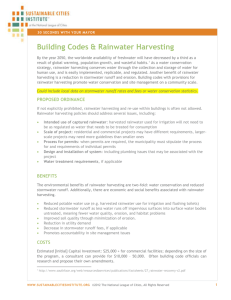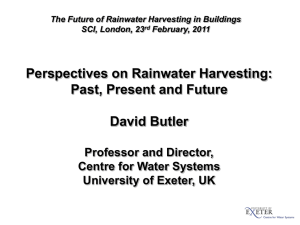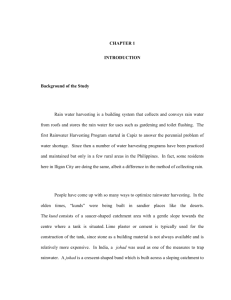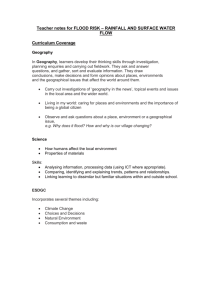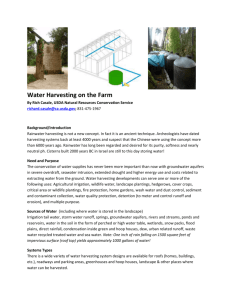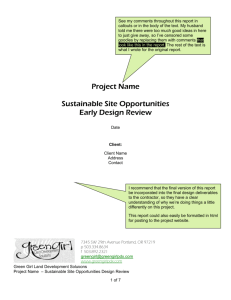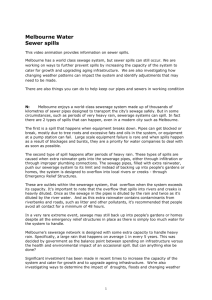Chapter 20: WATER AND BASIC DESIGN
advertisement
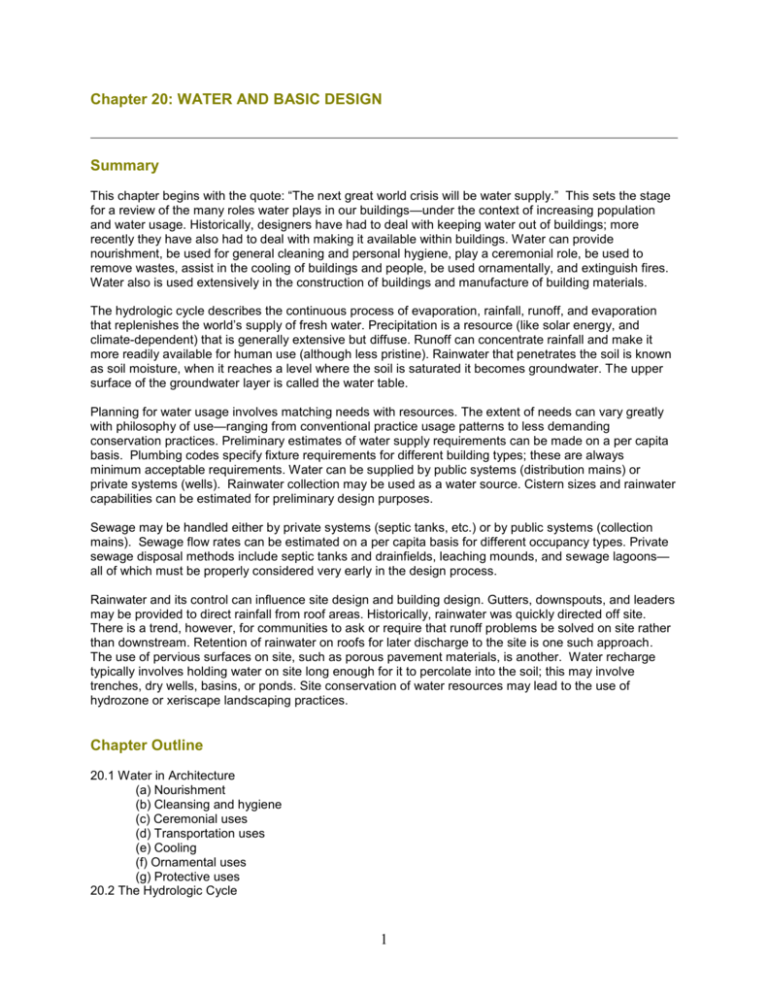
Chapter 20: WATER AND BASIC DESIGN Summary This chapter begins with the quote: “The next great world crisis will be water supply.” This sets the stage for a review of the many roles water plays in our buildings—under the context of increasing population and water usage. Historically, designers have had to deal with keeping water out of buildings; more recently they have also had to deal with making it available within buildings. Water can provide nourishment, be used for general cleaning and personal hygiene, play a ceremonial role, be used to remove wastes, assist in the cooling of buildings and people, be used ornamentally, and extinguish fires. Water also is used extensively in the construction of buildings and manufacture of building materials. The hydrologic cycle describes the continuous process of evaporation, rainfall, runoff, and evaporation that replenishes the world’s supply of fresh water. Precipitation is a resource (like solar energy, and climate-dependent) that is generally extensive but diffuse. Runoff can concentrate rainfall and make it more readily available for human use (although less pristine). Rainwater that penetrates the soil is known as soil moisture, when it reaches a level where the soil is saturated it becomes groundwater. The upper surface of the groundwater layer is called the water table. Planning for water usage involves matching needs with resources. The extent of needs can vary greatly with philosophy of use—ranging from conventional practice usage patterns to less demanding conservation practices. Preliminary estimates of water supply requirements can be made on a per capita basis. Plumbing codes specify fixture requirements for different building types; these are always minimum acceptable requirements. Water can be supplied by public systems (distribution mains) or private systems (wells). Rainwater collection may be used as a water source. Cistern sizes and rainwater capabilities can be estimated for preliminary design purposes. Sewage may be handled either by private systems (septic tanks, etc.) or by public systems (collection mains). Sewage flow rates can be estimated on a per capita basis for different occupancy types. Private sewage disposal methods include septic tanks and drainfields, leaching mounds, and sewage lagoons— all of which must be properly considered very early in the design process. Rainwater and its control can influence site design and building design. Gutters, downspouts, and leaders may be provided to direct rainfall from roof areas. Historically, rainwater was quickly directed off site. There is a trend, however, for communities to ask or require that runoff problems be solved on site rather than downstream. Retention of rainwater on roofs for later discharge to the site is one such approach. The use of pervious surfaces on site, such as porous pavement materials, is another. Water recharge typically involves holding water on site long enough for it to percolate into the soil; this may involve trenches, dry wells, basins, or ponds. Site conservation of water resources may lead to the use of hydrozone or xeriscape landscaping practices. Chapter Outline 20.1 Water in Architecture (a) Nourishment (b) Cleansing and hygiene (c) Ceremonial uses (d) Transportation uses (e) Cooling (f) Ornamental uses (g) Protective uses 20.2 The Hydrologic Cycle 1 20.3 Basic Planning (a) Water supply (b) Cisterns (c) Required facilities (d) Sewage 20.4 Rainwater 20.5 Collection and Storage 20.6 Rainwater and Site Planning (a) Roof retention (b) Porous pavement (c) Site design for recharging 20.7 Components References Key Concepts hydrologic cycle (as a driving force behind water resources) water characteristics (reflectivity, liquidity, life-sustaining) potable water (suitable for human consumption) sewage (sewer; liquid-borne waste) current and conservation practices (as they differentially affect water demands) plumbing fixture (as a user of water and supplier of wastes) cistern (for rainwater storage) catchment area (the collector size for rainfall resources) plumbing code (for minimum acceptable practices) septic tank (a means of private disposal of sewage) drainfield (an adjunct to the septic tank) groundwater recharge (as a philosophy for runoff control or good water management) roof retention ( as a means of reducing runoff) hydrozone (as a landscape planning concept) xeriscape (as a landscaping approach) Terminology and Metrics Important Terminology potable storm sewer combined sewer sanitary drainage (or sewer) precipitation runoff soil moisture groundwater water table cistern low-flush toilet porous concrete incremental paving open-celled paver gutter leader downspout 2 Important Metrics g/cd (gallons per capita per day) [also see Table 20.1 for typical water-related units] Links to Resources U.S. Geological Survey, Water Resources of the United States: http://water.usgs.gov/ A Sourcebook for Green and Sustainable Building (xeriscape): http://www.greenbuilder.com/sourcebook/xeriscape.html 3
